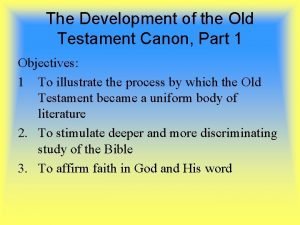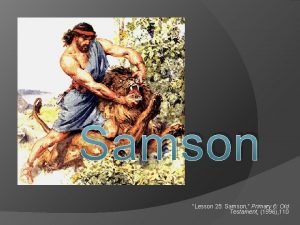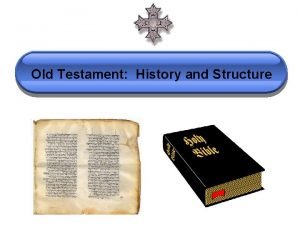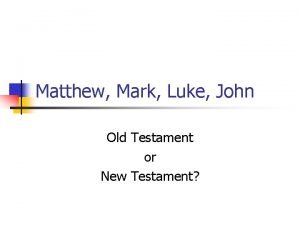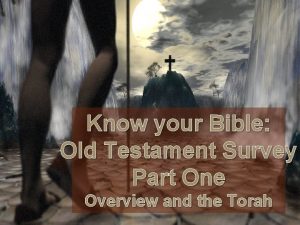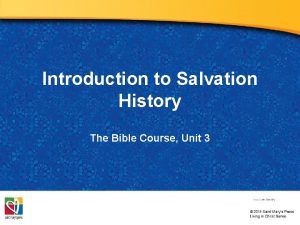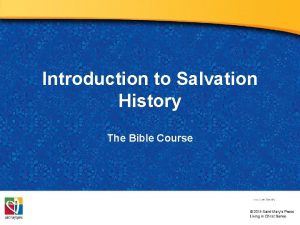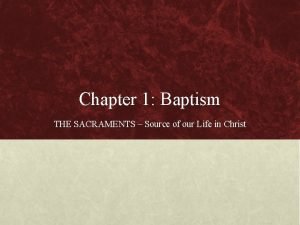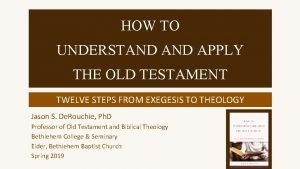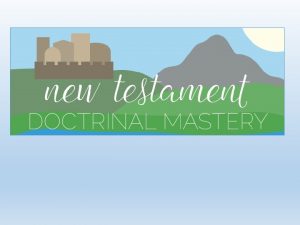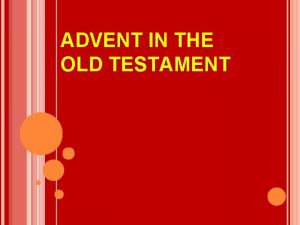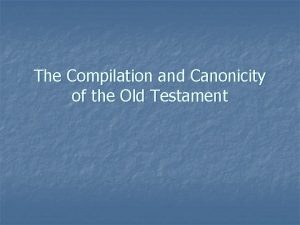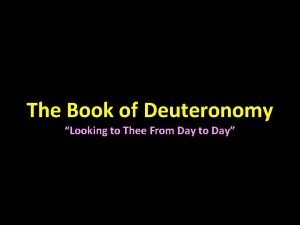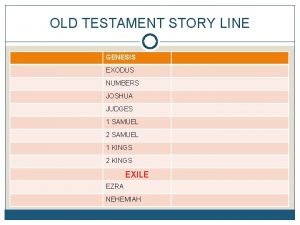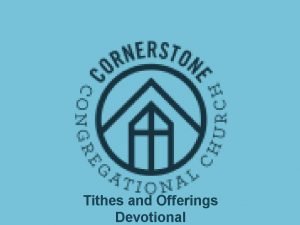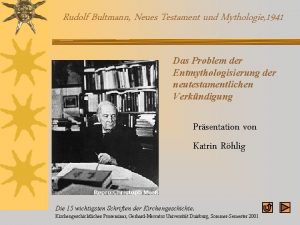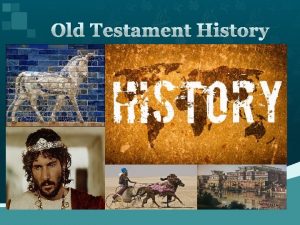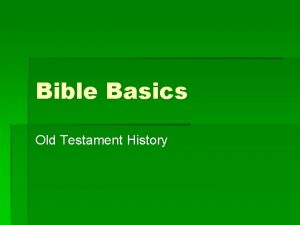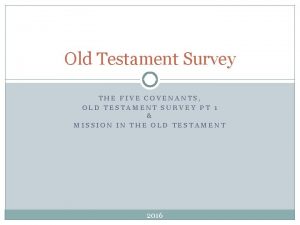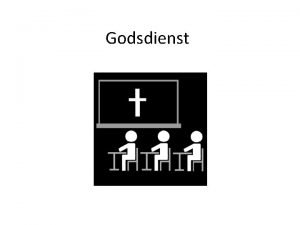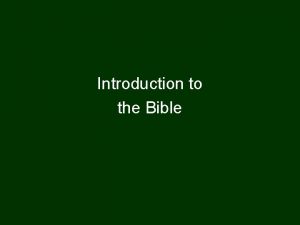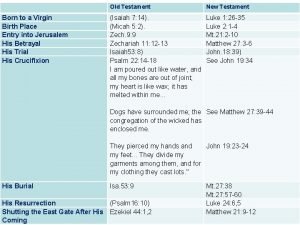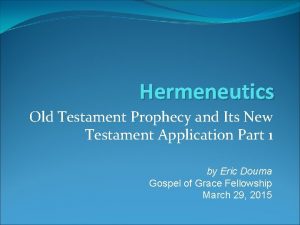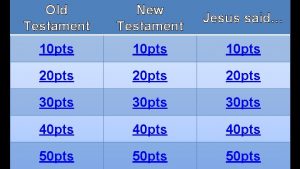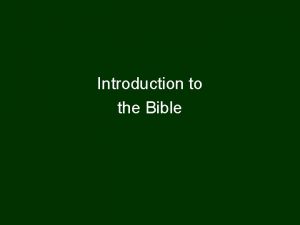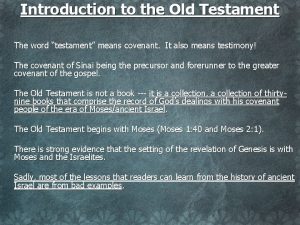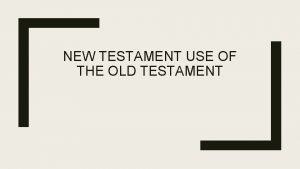THE OLD TESTAMENT WORLD The OT comes from


































- Slides: 34

THE OLD TESTAMENT WORLD The OT comes from a specific time and place, a definite world very different from our own. • Its world is pre-Classical • It precedes the Greek and the Romans. • It comes from the Axial Age (800 to 200 BCE) This age was a turning point in human history, as the revolutionary ideas of ethical monotheism (Israel) and philosophical rationalism (Greek) transformed human civilization. © Cambridge University Press 2014

DISCUSSION What do you already know about the ancient Near East and its history? © Cambridge University Press 2014

THE ANCIENT NEAR EAST The Ancient Near East (adapted from Yohanan Aharoni and Michael Avi-Yonah, The Mac. Millan Bible Atlas, p. 13) © Cambridge University Press 2014

THREE SUB-REGIONS OF ANE 1) Mesopotamia (Greek “between the rivers” – a reference to the Tigris and Euphrates) 2) Egypt 3) Syria-Palestine / The Levant © Cambridge University Press 2014

ANCIENT EGYPT Ancient Egypt (adapted from John Baines and Jaromír Málek, Cultural Atlas of Ancient Egypt, revised ed. , p. 43) © Cambridge University Press 2014

THE LEVANT Drawn by the author © Cambridge University Press 2014

REGIONS OF SYRIA-PALESTINE 1) Coastal Region or Shoreline 2) Western Mountainous Ridge 3) Central Rift Valley 4) Eastern Mountains Upland Plateau © Cambridge University Press 2014

THE ANCIENT NEAR EAST Adapted from Wesley Study Bible, map #1 © Cambridge University Press 2014

ANCIENT HIGHWAYS Adapted from Yohanan Aharoni and Michael Avi-Yonah, The Mac. Millan Bible Atlas, p. 16, map 9 © Cambridge University Press 2014

THE SOUTHERN LEVANT The ancient Israelites lived in the Southern Levant, which was a precarious place to live. It was susceptible to • prolonged periods of drought • enemy attack from nearly every direction © Cambridge University Press 2014

DISCUSSION Do you know of any stories in the Old Testament that reflect these realities of life in the Levant? © Cambridge University Press 2014

WORLD HISTORY One challenge in studying the early history is the lack of a precise chronological system. We use a three-age system: Stone, Bronze and Iron This system assumes an ever-increasing advancement in tools and weapon technology. © Cambridge University Press 2014

CHRONOLOGY OF ANE HISTORY © Cambridge University Press 2014

THIRD MILLENNIUM BCE History proper begins with writing, which appears to have been inverted by the Sumerians. By the 3 rd millennium BCE, advanced cultures in Egypt (Old Kingdom) and Mesopotamia (Sumerians & Akkadians) were producing lots of texts. © Cambridge University Press 2014

THE PYRAMIDS OF GIZA Art Resource; image reference: ART 5455; photo credit: “Erich Lessing/Art Resource, NY” © Cambridge University Press 2014

SECOND MILLENNIUM BCE Semites known as Amurru or Amorites appear in Mesopotamia. • Take control of the Sumero-Akkadian city states • Establish Babylon as the center for a powerful dynasty (ca. 2000 -1595 BCE) • Most notable for King Hammurabi (1792 -1750 BCE) and his law code • Establish the cultural foundations of Mesopotamia for centuries © Cambridge University Press 2014

THE CODE OF HAMMURABI Art Resource; image reference: ART 37065; photo credit: “Erich Lessing / Art Resource, NY” © Cambridge University Press 2014

SECOND MILLENNIUM BCE Egyptian civilization achieved its classical phrase during the first three centuries of this millennium. From 1730 – 1550 BCE, Egypt was ruled by outsiders known as Hyksos. The Egyptians regained control and established a period of stability and strength. During this period, the king became known as the “great house” or Pharaoh © Cambridge University Press 2014

SECOND MILLENNIUM BCE During this period, Amenophis IV experimented with monotheism. Under his rule: • Aten, the sun-god, absorbed the features of the other deities • A new royal city named Akhetaten (modern el. Amarna) was established • He changed his name to Akhenaten However, this experiment with monotheism was short lived. © Cambridge University Press 2014

SECOND MILLENNIUM BCE The 2 nd half of the millennium was a period of internationalism marked by: • A balance of power across the ANE • The use of Akkadian as a universal language for commerce and diplomacy • An archive of 382 texts discovered in 1887 at El. Amarna containing letters between the rulers of Egypt, Syra-Palestine and Mesopotamia over a 30 year period © Cambridge University Press 2014

AMARNA LETTER Art Resource; image reference: ART 186785; photo credit: “© The Trustees of the British Museum /Art Resource, NY” © Cambridge University Press 2014

SECOND MILLENNIUM BCE Around 1200 BCE. . . • The dominant nation-states of the Mediterranean rim all collapsed within 50 years of each other. • We do not know exactly why this happened. • Egyptian inscriptions indicate the arrival of displaced “Sea Peoples” were an important part of this transition. © Cambridge University Press 2014

SECOND MILLENNIUM BCE The Iron Age marks the beginning of. . . • Hundreds of years of political struggle and cultural change in the Levant • The use of alphabetic scriptures • Israel’s occupation of the central highlands of Canaan. © Cambridge University Press 2014

FIRST MILLENNIUM BCE In Mesopotamia. . . • Civilizations were less affected by the collapse of the Late Bronze Age. • This relative stability led to the emergence of the world’s first real empires: 1. Assyria 2. Babylonia 3. Persia © Cambridge University Press 2014

FIRST MILLENNIUM BCE The Assyrian Empire. . . • Began under Tiglath-pileser III (745 -727 BCE) • Controlled all of Mesopotamia & Syria-Palestine • Their dominance lasted from 745 - 610 BCE • They captured Samaria in 722 BCE • They besieged Jerusalem in 701 BCE © Cambridge University Press 2014

FIRST MILLENNIUM BCE The Babylonian Empire. . . • Gained control after the fall of the Assyrians • Brief empire (604 -539 BCE) • King Nebuchadnezzar II (604 -562 BCE) was its most notable king • His army destroyed Jerusalem in 586 BCE and sent Judah’s inhabitants into exile. © Cambridge University Press 2014

FIRST MILLENNIUM BCE The Persian Empire. . . • Also known as the Achaemenid Empire • The last native Mesopotamian empire • King Cyrus II or Cyrus the Great (559 – 530 BCE was its most notable king © Cambridge University Press 2014

FIRST MILLENNIUM BCE In 539 BCE, King Cyrus captured Babylon, released the Jews and allowed them to return to Jerusalem officially ending the Exile. The Jews who returned from Babylonia joined with those who never left the region to form the Persian province of Yehud, which was a modest community around Jerusalem. © Cambridge University Press 2014

FIRST MILLENNIUM BCE Cyrus the Great’s successors expanded the empire to Egypt and Anatolia, coming to a famous standoff with the Greeks. Beginning in 334 BCE, Alexander the Great marched through the Levant, Egypt and Mesopotamia, capturing Babylon in 331 and ending the Persian Empire. © Cambridge University Press 2014

FIRST MILLENNIUM BCE During this time, the religious traditions of the ANE were remarkably consistent. Complex polytheism was the dominant conviction of ancient peoples. Israel’s monolatrous henotheism, developing into genuine monotheism, was unique. © Cambridge University Press 2014

THE OLD TESTAMENT STORY Within this ANE historical background, Israel gives a surprisingly honest account of its own history. The driving purpose of this account is to explore Israel’s relationship with God. In this way, the OT is first and foremost a theological statement told as a story. © Cambridge University Press 2014

DISCUSSION What do you already know about Israel’s story? © Cambridge University Press 2014

THE OLD TESTAMENT STORY • Ancestral Beginnings: Covenant & Promises (Abraham, Isaac and Jacob) • Deliverance from Egypt & Covenant at Mt. Sinai (Moses) • Conquest of the Promised Land (Joshua) © Cambridge University Press 2014

THE OLD TESTAMENT STORY • Tumultuous period of the judges-rule • United Monarchy (Saul, David, Solomon) • Two Kingdoms: Israel and Judah • Exile and Restoration © Cambridge University Press 2014
 Ot canon
Ot canon Was samson a judge
Was samson a judge Doctrinal mastery core document.
Doctrinal mastery core document. Bible old testament
Bible old testament Matthew mark luke john old testament
Matthew mark luke john old testament Old testament survey part 1
Old testament survey part 1 O a an amos an chart
O a an amos an chart Old testament promises
Old testament promises Salvation history in the old testament
Salvation history in the old testament Introduction to salvation
Introduction to salvation Mission in the old testament
Mission in the old testament How is baptism prefigured in the old testament
How is baptism prefigured in the old testament What is the old testament all about
What is the old testament all about Books in old testament how many
Books in old testament how many How to understand and apply the old testament
How to understand and apply the old testament Old testament doctrinal mastery
Old testament doctrinal mastery Titus old or new testament
Titus old or new testament Advent in the old testament
Advent in the old testament Old testament canon timeline
Old testament canon timeline Leah old testament
Leah old testament Welcoming god's kingdom
Welcoming god's kingdom Deuteronomy 5:19
Deuteronomy 5:19 Old testament jewish temple layout
Old testament jewish temple layout Ignatius old testament study bible
Ignatius old testament study bible Redemption cycle
Redemption cycle Primates characteristics
Primates characteristics Did pumpkins come from the new world or old world
Did pumpkins come from the new world or old world First comes love, then comes marriage
First comes love, then comes marriage What's your name? how old are you?
What's your name? how old are you? Long long long ago there lived a little girl
Long long long ago there lived a little girl Once upon a time there lived an old man and an old woman
Once upon a time there lived an old man and an old woman Hansel once upon a time
Hansel once upon a time What comes to your mind when you hear the word social
What comes to your mind when you hear the word social Encouragement about giving tithes and offering
Encouragement about giving tithes and offering Bultmann neues testament und mythologie
Bultmann neues testament und mythologie
